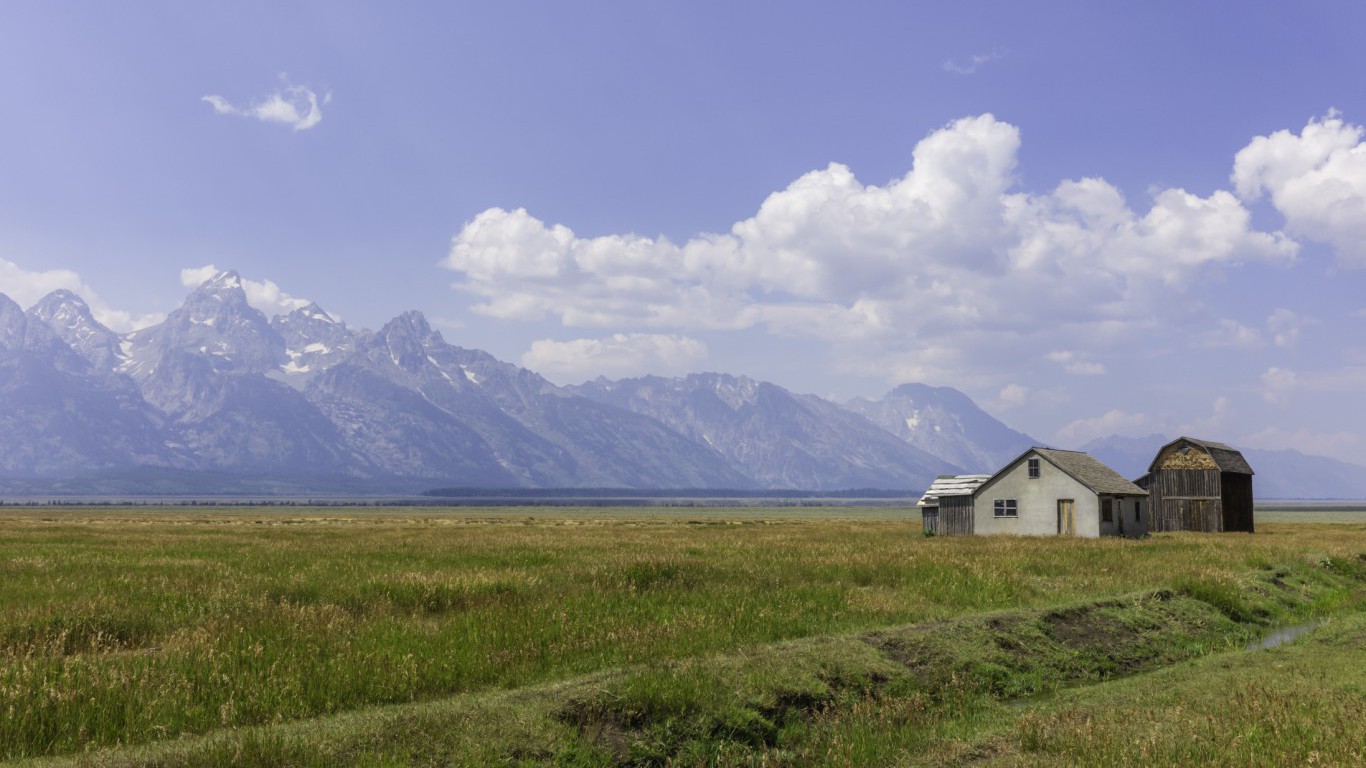Special Report
Ranking Gender Inequality in All 50 States

Published:
Last Updated:

For many Americans, the election of Donald Trump represents a step back for the feminist movement. Whether or not the president-elect’s policies will result in meaningful progress for women’s rights, there remain severe inequalities the nation has yet to overcome.
These issues include a gender pay gap, a lack of flexibility in the workplace during pregnancy and early motherhood, and, indeed, a lack of women holding positions of political influence. While no state has achieved gender pay equality, a number have made substantial progress in closing the earnings gap and in other areas, like electing women to office, funding pre-K programs, and passing laws that allow women to stay in the workforce when they have children, should they so choose.
[in-text-ad]
On the other hand, a number of states remain extremely unfavorable to women in every major category. 24/7 Wall St. reviewed and ranked the 50 states based on their favorability to women.
Click here to see how your state ranks in gender equality.
Click here to read our full methodology.
Perhaps the most egregious component of gender inequality in the U.S. is the wage gap. Though the severity of the wage gap varies by state, nationwide, the typical woman working full time earns 80 cents for every dollar a man earns. No state has a larger gap than Wyoming, however, where women earn roughly 64 cents for every dollar. With lower incomes, women are also far more likely to live in poverty than men.
In an interview with 24/7 Wall St., Julie Anderson, a research associate at the Institute for Women’s Policy Research, explained why the wage gap exists. According to Anderson, “the largest contributor to the wage gap is occupational segregation.” Men are more likely to be hired in higher paying, managerial roles than women. Though the share ranges from state to state, nationwide, fewer than 40% of management positions are held by women.
According to Anderson, women are also far more likely than men to work in low wage, part-time jobs. Since the wage gap only measures the incomes of men and women working full time, the problem is even more pronounced than the data indicates.
Maternity, Anderson explained, can lead to lower overall incomes for women, particularly as raising a child can often lead women to exit the workforce for good. “If a family has to choose between someone being fully engaged in work and someone being a caregiver, the logical choice is the one who earns less will be the one to back off, and in most cases that will be the woman in the family.”
While the Family & Medical Leave Act of 1993 mandates that most working mothers must be allowed 12 weeks maternity leave, a number of states have additional policies in place both for public employees and the private sector workforce. Many states extend the minimum number of weeks, allow women to use sick days to cover pre- and post-natal care, and, in some cases, mandate paid leave for both mothers and fathers.
Another state policy that has shown to be advantageous to young mothers is a taxpayer-funded pre-Kindergarten program. Besides being instrumental in childhood development, pre-K programs give parents the opportunity to leave their children somewhere safe during the day.
Anderson explained that as mothers are more often tasked with the responsibility of watching young children, this means women avoid the expenses of private daycare, and also will have an easier time returning to the workforce. Eight states have no taxpayer-funded pre-K, and partially as a result rank among the worst for women in the country.
Female representation in government is also an important aspect of gender equality, and elected government positions are held primarily by men. Nearly half of all states have never had a female governor and women comprise an average of less than 25% of state legislatures. According to Anderson, this is problematic both because it may discourage women from running for elected office and because male politicians are less likely to implement reform related to gender equality. Anderson explained that while women are less likely to run for office, when they do, they tend win at the same rates as men.
See how your state ranks in gender equality.

1. Rhode Island
> Female earnings as pct. of male: 85.8% (5th highest)
> Pct. mgmt. jobs held by women: 43.6% (5th highest)
> Pct. 3-4 yr. olds enrolled in state pre-K: 1.4% (11th lowest)
> Pct. legislative seats held by women: 27.4% (18th highest)
Across a range of measures related to health, leadership, and financial security, Rhode Island is the best state in the country for women. With mandated special accommodations for pregnant workers and expansions to the federal Family and Medical Leave Act of 1993 for both private and public sector jobs, Rhode Island has taken considerable steps to address gender inequality.
[in-text-ad]
Female representation in leadership roles is also an important component of gender equality. In November 2014, Rhode Island voters elected Gina Raimondo as governor. Raimondo is one of six sitting female governors in the country and the first in Rhode Island history.

2. New York
> Female earnings as pct. of male: 88.7% (the highest)
> Pct. mgmt. jobs held by women: 41.6% (12th highest)
> Pct. 3-4 yr. olds enrolled in state pre-K: 23.9% (11th highest)
> Pct. legislative seats held by women: 24.4% (24th lowest)
Nationwide, women earn only 80% of what their male counterparts earn. While the pay gap exists in every state, it is smallest in New York, where women earn 88.7% of the median male salary.
Providing state-funded pre-K programs for three- and four-year-olds is important for gender equality as it allows for both parents to participate in the workforce. New York spends an above average amount on pre-K programs per student. In addition, 23.9% of three- and four-year-olds in the Empire State are enrolled in a public pre-K program, far more than most states.

3. California
> Female earnings as pct. of male: 85.7% (6th highest)
> Pct. mgmt. jobs held by women: 40.7% (19th highest)
> Pct. 3-4 yr. olds enrolled in state pre-K: 12.9% (23rd highest)
> Pct. legislative seats held by women: 25.8% (20th highest)
Women hold a relatively high share of government leadership positions in California. Of all 55 of the state’s congressional representatives, 38.2% are female.
Included among them are some of the most influential leaders in Washington. Rep. Nancy Pelosi, who represents the state’s 12 District, was the first female Speaker of the House in U.S. history. Additionally, both California senators are female, including Senior Sen. Dianne Feinstein, who is vice chairperson of the Intelligence Committee and a member of the Appropriations Committee.

4. Oregon
> Female earnings as pct. of male: 80.8% (20th highest)
> Pct. mgmt. jobs held by women: 40.8% (17th highest)
> Pct. 3-4 yr. olds enrolled in state pre-K: 8.2% (22nd lowest)
> Pct. legislative seats held by women: 31.1% (9th highest)
A strong pre-K program can be extremely beneficial for women who might otherwise have to take additional time off or pay out of pocket for childcare. And Oregon has one of the best-funded pre-K systems in the country, with $8,648 in state money apportioned per child.
Oregon has a number of other mother-friendly policies. It is one of just a handful of states to mandate that private sector companies with at least 10 employees allow workers to use paid sick days for prenatal or postnatal care.

5. Connecticut
> Female earnings as pct. of male: 82.4% (14th highest)
> Pct. mgmt. jobs held by women: 40.4% (22nd highest)
> Pct. 3-4 yr. olds enrolled in state pre-K: 16.2% (18th highest)
> Pct. legislative seats held by women: 28.3% (15th highest)
By a number of measures related to health, financial security, and legislation, Connecticut is the fifth best state for women in the country and the second best in New England. The pay gap between men and women is slightly smaller than it is nationwide, and Connecticut voters have elected more women to fill state legislature and congressional delegate seats than is typical.
Of the 37 female state governors in U.S. history, two served in the Nutmeg State. Elected in 1974 to the highest office in state politics, Ella Grasso was the first female governor in Connecticut and the first in the country not to be married to a former governor.

6. Hawaii
> Female earnings as pct. of male: 84.1% (8th highest)
> Pct. mgmt. jobs held by women: 42.5% (9th highest)
> Pct. 3-4 yr. olds enrolled in state pre-K: 1% (10th lowest)
> Pct. legislative seats held by women: 28.9% (14th highest)
In every state in the country, a larger share of women than men live in poverty. In Hawaii, however, just 52.3% of women in the state live in poverty, compared to a national share of 55.4%.
[in-text-ad]
This relatively small gap can likely be explained in part by the state’s relatively small gender pay gap. Women in the state earn 84 cents for every dollar earned by the typical male. Nationwide, the typical female worker earns only 80% of the median earnings for men.

7. Vermont
> Female earnings as pct. of male: 83.8% (9th highest)
> Pct. mgmt. jobs held by women: 43.6% (5th highest)
> Pct. 3-4 yr. olds enrolled in state pre-K: 54.6% (the highest)
> Pct. legislative seats held by women: 40.6% (2nd highest)
Pre-K can be invaluable to mothers — in addition to aiding in their child’s development at a crucial age, it affords them the opportunity to work, and also helps them avoid otherwise costly daycare services.
This July, roughly two years after the pre-K mandate law was initially passed, Vermont became the first state in the country to officially implement universal, publicly-funded, pre kindergarten programs for three- and four-year-old children. As of the 2014-2015 school year, the state already had the highest enrollment, at 54.6%, and this figure will likely rise in the coming years.

8. New Jersey
> Female earnings as pct. of male: 82.0% (16th highest)
> Pct. mgmt. jobs held by women: 37.6% (8th lowest)
> Pct. 3-4 yr. olds enrolled in state pre-K: 23.6% (12th highest)
> Pct. legislative seats held by women: 30.0% (11th highest)
New Jersey spends more on pre-K education than any other state. The state allocates the equivalent of $12,149 per child on pre-K education, well more than double the national average. In addition to the state’s higher spending per student, New Jersey has relatively high pre-K enrollment — 23.6% of three- and four-year-olds in New Jersey are enrolled in state pre-K programs. Early childhood education is important for cognitive development and allows both parents to participate in the workforce.

9. Washington
> Female earnings as pct. of male: 79.0% (24th highest)
> Pct. mgmt. jobs held by women: 40.9% (15th highest)
> Pct. 3-4 yr. olds enrolled in state pre-K: 5.6% (19th lowest)
> Pct. legislative seats held by women: 33.3% (4th highest)
Female representation in positions of political power can be instrumental in creating policy favorable to gender equality. In Washington, 41.7% of the state’s congressional delegation is female. While that seems low, it is actually the fourth highest percentage among states. Less than 20% of Congress is female.
The state is also one of just seven to have had more than one female governor in its history.

10. Massachusetts
> Female earnings as pct. of male: 83.1% (13th highest)
> Pct. mgmt. jobs held by women: 43.9% (3rd highest)
> Pct. 3-4 yr. olds enrolled in state pre-K: 7% (21st lowest)
> Pct. legislative seats held by women: 25.5% (21st highest)
In Massachusetts, the typical woman working full time earns $51,343 a year, more than in any other state in the country. Despite the relatively high earnings, women in the Bay State earn an average of 83 cents for every dollar men make.
Legislation in Massachusetts protecting working women is also lagging behind some other states. Under the Family & Medical Leave Act of 1993, workers across the country are allowed to take 12 weeks of unpaid time off of work for a number of reasons, including childbirth and caring for an ill child. Massachusetts has expanded on that law for public sector workers but has not taken significant action to increase protections for private sector workers.

11. New Mexico
> Female earnings as pct. of male: 84.6% (7th highest)
> Pct. mgmt. jobs held by women: 43.0% (7th highest)
> Pct. 3-4 yr. olds enrolled in state pre-K: 15.1% (22nd highest)
> Pct. legislative seats held by women: 26.8% (19th highest)
Women are more likely to have influential leadership positions in New Mexico than in most other states. Statewide, women hold 43% of jobs in management, slightly more than is typical across the country. Furthermore, the state is one of only six in the country with a female governor, and Congresswoman Michelle Grisham has represented the New Mexico’s 1st district in Washington since 2013.
[in-text-ad]
The state could improve conditions for women by expanding pre-K programs to admit three-year-olds. Currently, New Mexico is one of nearly two dozen states to have no taxpayer funded pre-K programs for three-year-olds.

12. Minnesota
> Female earnings as pct. of male: 81.1% (17th highest)
> Pct. mgmt. jobs held by women: 37.9% (11th lowest)
> Pct. 3-4 yr. olds enrolled in state pre-K: 0.9% (9th lowest)
> Pct. legislative seats held by women: 33.3% (4th highest)
One third of Minnesota’s state legislature and a fifth of its congressional delegation are female, including the state’s senior senator, Amy Klobuchar. While women have a larger than typical role in Minnesota politics, they are notably underrepresented in management jobs. Only 37.9% of management roles in the state are held by women, one of the smaller percentages in the country.
As is true nationwide, women earn less than men in Minnesota, despite higher high school diploma and bachelor’s degree attainment rates.

13. Maryland
> Female earnings as pct. of male: 83.6% (11th highest)
> Pct. mgmt. jobs held by women: 43.7% (4th highest)
> Pct. 3-4 yr. olds enrolled in state pre-K: 20.2% (15th highest)
> Pct. legislative seats held by women: 31.4% (7th highest)
Nationwide, women are more likely than men to live in poverty. The discrepancy is especially stark in Maryland. Women represent 58% of all people living below the poverty line in the state, the largest share in the country.
Women do hold a relatively large share of powerful jobs in Maryland, however. Nearly 44% of management jobs in the state are held by women, and 20% of the state’s congressional delegation is female, including senior Senator Barbara Mikulski, who has been serving since 1987. After serving in the U.S. Senate longer than any woman in history, Mikulski is not running for reelection in 2016.

14. Maine
> Female earnings as pct. of male: 78.5% (22nd lowest)
> Pct. mgmt. jobs held by women: 45.3% (the highest)
> Pct. 3-4 yr. olds enrolled in state pre-K: 18.3% (16th highest)
> Pct. legislative seats held by women: 29.0% (12th highest)
Gender inequality is not an issue in terms of representation in Maine’s congressional delegation. The gender split among the state’s representation on Capitol Hill is 50/50 and includes Susan Collins, who has served as a senator for nearly two decades.
Maine is also notable for the large share of women working in management positions. Women hold more than 45% of all management jobs in Maine, the largest percentage of any state in the country.

15. Illinois
> Female earnings as pct. of male: 79.2% (23rd highest)
> Pct. mgmt. jobs held by women: 39.3% (22nd lowest)
> Pct. 3-4 yr. olds enrolled in state pre-K: 23.4% (13th highest)
> Pct. legislative seats held by women: 31.1% (9th highest)
Women working in public sector jobs in Illinois enjoy more family benefits than their private sector counterparts. While women in both the private and public sector in the state benefit from employer pregnancy accommodations and right-to-pump laws that expand on federal regulations, only public sector workers have the option of more time off than is granted under the federal Family & Medical Leave Act of 1993, which allows 12 weeks of unpaid time off from work for a number of reasons, including childbirth and caring for an ill child.

16. Delaware
> Female earnings as pct. of male: 88.5% (2nd highest)
> Pct. mgmt. jobs held by women: 43.0% (7th highest)
> Pct. 3-4 yr. olds enrolled in state pre-K: 3.7% (17th lowest)
> Pct. legislative seats held by women: 24.2% (23rd lowest)
Nationwide, working women earn an average of 80% of their male counterparts’ wages. In Delaware, while income inequality still exists, it is considerably less pronounced. The typical salary among a woman working full time is 88.5% of the typical man’s salary.
[in-text-ad]
Women hold relatively few elected political positions in Delaware. Though women comprise 24% of the state legislature, roughly in line with the corresponding national average, none of the state’s three congressional delegates are female.

17. Wisconsin
> Female earnings as pct. of male: 78.3% (21st lowest)
> Pct. mgmt. jobs held by women: 38.4% (16th lowest)
> Pct. 3-4 yr. olds enrolled in state pre-K: 32.5% (6th highest)
> Pct. legislative seats held by women: 25.0% (22nd highest)
State funded pre-K programs, while important for children’s cognitive development, also allow both parents to participate in the work force. More specifically, they can allow mothers to work and maintain financial independence without having to pay for private daycare or pre-K programs. In Wisconsin, a state that invests $3,802 per child on day care services, 63.7% of four-year-olds are enrolled in a taxpayer-funded daycare program, a larger share than in all but four other states.

18. New Hampshire
> Female earnings as pct. of male: 76.4% (14th lowest)
> Pct. mgmt. jobs held by women: 40.2% (23rd highest)
> Pct. 3-4 yr. olds enrolled in state pre-K: 0% (the lowest)
> Pct. legislative seats held by women: 29.0% (12th highest)
Women hold considerable political power in New Hampshire. The state is one of only six to have a sitting female governor, and three out of four of the state’s congressional delegates are women, including both senators.
Despite considerable female representation in elected office, however, there are few legal provisions in place for pregnant women in the workplace. Neither public nor private sector employers in New Hampshire are required to make in-office accommodations for pregnant employees.

19. Colorado
> Female earnings as pct. of male: 80.8% (21st highest)
> Pct. mgmt. jobs held by women: 38.4% (16th lowest)
> Pct. 3-4 yr. olds enrolled in state pre-K: 15.7% (21st highest)
> Pct. legislative seats held by women: 42.0% (the highest)
Women have considerable influence over laws in Colorado. Off the 100 state legislators, 42 are women, the largest share of any state in the country.
Women are less likely to have powerful roles in non-elected positions, however. Only 38% of management positions in Colorado are held by women, compared to 40% nationwide.

20. North Carolina
> Female earnings as pct. of male: 85.9% (4th highest)
> Pct. mgmt. jobs held by women: 41.0% (13th highest)
> Pct. 3-4 yr. olds enrolled in state pre-K: 10.9% (24th highest)
> Pct. legislative seats held by women: 22.4% (20th lowest)
Nationwide, the typical salary for a woman working full-time is only about 80% of a comparable male salary. In North Carolina, the wage gap is slightly smaller. Women in the state earn about 86% of what men make.
State laws in North Carolina do not go especially far to protect women in the workplace, however. The state has not passed major legislation to expand federally mandated provisions concerning family leave for private sector jobs and pregnancy accommodations for both private, and public sector workers.

21. Florida
> Female earnings as pct. of male: 86.6% (3rd highest)
> Pct. mgmt. jobs held by women: 39.9% (23rd lowest)
> Pct. 3-4 yr. olds enrolled in state pre-K: 38.2% (3rd highest)
> Pct. legislative seats held by women: 25.0% (22nd highest)
State sponsored pre-K programs make it easier for women with young children to work and remain financially secure. Florida’s pre-K program is one of the most successful in the country as more than three-quarters of four-year-olds in the state are enrolled. There is room for improvement, however, as the state does not offer taxpayer-funded pre-K for three-year-olds.
[in-text-ad]
The state could also do more to expand working women’s rights in the private sector. While public sector employees can take more than the 12 weeks unpaid time off for family issues mandated by the federal government, private sector workers have no such guarantee.

22. Arizona
> Female earnings as pct. of male: 83.5% (12th highest)
> Pct. mgmt. jobs held by women: 42.0% (11th highest)
> Pct. 3-4 yr. olds enrolled in state pre-K: 4.2% (18th lowest)
> Pct. legislative seats held by women: 35.6% (3rd highest)
Women have greater influence on Arizona law than in nearly any other state. Roughly 36% of Arizona’s state legislature is comprised of women, a higher share than all but three other states. Additionally, four of Arizona’s governors have been women, including Janet Napolitano, who went on to serve as the Secretary of Homeland Security under President Barack Obama.
Despite the share of women elected to state government, Arizona has some of the weakest family-related workplace protections in the country. Accommodations for pregnant workers are not mandated, and there are no paid or extended unpaid leave guarantees for workers in either private or public sector jobs.

23. Alaska
> Female earnings as pct. of male: 77.9% (19th lowest)
> Pct. mgmt. jobs held by women: 40.2% (23rd highest)
> Pct. 3-4 yr. olds enrolled in state pre-K: 1.5% (12th lowest)
> Pct. legislative seats held by women: 28.3% (15th highest)
More than 15% of women in Alaska do not have health insurance, which is the second highest percentage in the country. A lack of insurance may mean some women are unable to get the care they need, and this can affect outcomes related to health issues specific to women, such as pregnancy. However, the state’s rate of maternal death during childbirth and its infant mortality rate are each among the lowest in the country.

24. West Virginia
> Female earnings as pct. of male: 70.6% (3rd lowest)
> Pct. mgmt. jobs held by women: 40.7% (19th highest)
> Pct. 3-4 yr. olds enrolled in state pre-K: 39.5% (2nd highest)
> Pct. legislative seats held by women: 14.9% (6th lowest)
While women typically earn less than men nationwide, the gender pay gap is an even bigger issue in West Virginia. Women working full-time typically earn less than 71% of what men earn. Nationwide, women earn 80% of the typical male salary.
Still, women in West Virginia with young children are more likely to work, and remain financially secure, than in many other states due to the taxpayer-funded pre-K program. In West Virginia, 39.5% of three- and four-year-olds are enrolled in a state-funded pre-K program, the second largest share in the country.

25. Arkansas
> Female earnings as pct. of male: 78.9% (24th lowest)
> Pct. mgmt. jobs held by women: 40.0% (25th lowest)
> Pct. 3-4 yr. olds enrolled in state pre-K: 29.9% (7th highest)
> Pct. legislative seats held by women: 20.0% (15th lowest)
Women are clearly underrepresented in elected office in Arkansas. None of the state’s six congressional representatives are female and the state has never had a female governor.
Despite the lack of female representation in Arkansas politics, the state has a taxpayer-funded pre-K system that makes it easier for both parents to participate in the workforce. Slightly more than 21% of three-year-olds in the state are enrolled in public pre-K.

26. South Carolina
> Female earnings as pct. of male: 80.9% (19th highest)
> Pct. mgmt. jobs held by women: 42.3% (10th highest)
> Pct. 3-4 yr. olds enrolled in state pre-K: 25.8% (10th highest)
> Pct. legislative seats held by women: 13.5% (4th lowest)
Having a high share of women in positions they have historically been excluded from is a good sign that progress has been made toward gender equality in a state. In South Carolina, 42.3% of those employed in management positions are women, one of the higher shares in the country.
[in-text-ad]
While South Carolina women are more likely to hold positions of power in the workplace, they are grossly underrepresented in politics, outside of current Governor Nikki Haley. The state is one of 13 with no women in Congress.. In addition, just 13.5% of the state legislators are women, the fourth-lowest share of any state.

27. Louisiana
> Female earnings as pct. of male: 68.0% (2nd lowest)
> Pct. mgmt. jobs held by women: 44.6% (2nd highest)
> Pct. 3-4 yr. olds enrolled in state pre-K: 16% (20th highest)
> Pct. legislative seats held by women: 11.8% (the lowest)
Policies that allow flexibility for time off after childbirth for both women and men can be instrumental in ensuring workplace equality. Louisiana has a number of policies conducive to gender equality in the workplace. State employers are legally required to allow a minimum of six weeks leave during pregnancy, and as much as four months, if there are complications.
Unfortunately, complications after pregnancy are more common in Louisiana than most states. The state’s infant mortality and maternal mortality rates are among the highest in the country.

28. Nevada
> Female earnings as pct. of male: 83.7% (10th highest)
> Pct. mgmt. jobs held by women: 41.0% (13th highest)
> Pct. 3-4 yr. olds enrolled in state pre-K: 1.9% (13th lowest)
> Pct. legislative seats held by women: 33.3% (4th highest)
Nevada has not expanded on any federally mandated protections for private or public sector workers related to family leave or pregnancy accommodations. In addition, at 7.2%, Nevada has the highest female unemployment rate of any state in the country.
Women face more challenges in Nevada than in many other states despite the relatively large share of female state legislators. Of the 63 legislative seats in Nevada state government, one third are held by women, one of the largest percentages in the country.

29. Tennessee
> Female earnings as pct. of male: 81.0% (18th highest)
> Pct. mgmt. jobs held by women: 39.1% (21st lowest)
> Pct. 3-4 yr. olds enrolled in state pre-K: 10.1% (25th highest)
> Pct. legislative seats held by women: 17.4% (11th lowest)
A woman has never been elected governor in Tennessee, and a smaller than average share of both the state legislature and the state’s congressional delegation are women. In addition, women in Tennessee are less likely to hold management positions than women nationwide.
Despite the state’s many shortcomings in terms of gender equality, Tennessee lawmakers have expanded on the federal Family & Medical Leave Act of 1993, allowing both private and public sector workers to take more than 12 weeks of unpaid time off from work. Reasons for taking leave include childbirth and caring for an ill child.

30. Iowa
> Female earnings as pct. of male: 76.7% (16th lowest)
> Pct. mgmt. jobs held by women: 33.8% (3rd lowest)
> Pct. 3-4 yr. olds enrolled in state pre-K: 32.8% (5th highest)
> Pct. legislative seats held by women: 22.7% (21st lowest)
Jobs in management tend be higher paying, and in Iowa, men are are far more likely to have management roles than women. Only one in three management positions in the state are held by women, a smaller share than in all but two other states.
The state does have its place in the historic fight for women’s rights in the U.S., however. Carrie Chapman Catt, a leading figure in the women’s suffrage movement and founder of the League of Women Voters, spent much of her childhood in Iowa and was educated at what is now Iowa State University.

31. Nebraska
> Female earnings as pct. of male: 78.8% (23rd lowest)
> Pct. mgmt. jobs held by women: 34.7% (5th lowest)
> Pct. 3-4 yr. olds enrolled in state pre-K: 22.1% (14th highest)
> Pct. legislative seats held by women: 22.4% (20th lowest)
That women are less likely to be hired for upper-level and management positions, also known as the glass ceiling, appears to be a serious problem in Nebraska. Just 34.7% of all management positions in the state are held by women, the fifth lowest percentage in the country.
[in-text-ad]
Despite this problem, Nebraska’s gender pay gap is not as severe as in some states. The typical female worker earns $36,834, or 78.8% of the median earnings for males in the state.

32. Pennsylvania
> Female earnings as pct. of male: 78.9% (25th lowest)
> Pct. mgmt. jobs held by women: 40.0% (25th lowest)
> Pct. 3-4 yr. olds enrolled in state pre-K: 8.9% (24th lowest)
> Pct. legislative seats held by women: 18.2% (12th lowest)
Women hold very few elected positions in Pennsylvania’s government. The state has never had a female governor and none of its 20 congressional delegates are women. Furthermore, only 18% of the state legislature is female, one of the smaller shares of any state.
With relatively few female politicians, Pennsylvania is not typically the site of major progressive legislation related to maternity. There are no mandated pregnancy accommodations or paid sick time or family leave for public or private sector employees in the Keystone State.

33. Michigan
> Female earnings as pct. of male: 74.3% (9th lowest)
> Pct. mgmt. jobs held by women: 38.8% (19th lowest)
> Pct. 3-4 yr. olds enrolled in state pre-K: 16.1% (19th highest)
> Pct. legislative seats held by women: 20.9% (17th lowest)
Women are more likely to stay employed when states mandate more flexible time off policies during and after pregnancy, and when they provide accommodations for parents with newborn children. Of the 14 major policies we reviewed related to maternity, Michigan is one of just nine states that does not impose requirements on public or private employers in any of these categories.

34. Kentucky
> Female earnings as pct. of male: 82.0% (15th highest)
> Pct. mgmt. jobs held by women: 38.0% (12th lowest)
> Pct. 3-4 yr. olds enrolled in state pre-K: 17% (17th highest)
> Pct. legislative seats held by women: 16.7% (8th lowest)
Women’s interests are likely not fully represented by elected officials in Kentucky as less than 17% of the state legislature and none of the eight congressional delegates are female. Perhaps, not surprisingly, the state has some of the least progressive worker protections regarding pregnancy and family leave in the country.
Kentucky women are also far more likely than those in other parts of the country to be financially insecure. More than one in four women in Kentucky live in poverty, one of the largest shares in the country.

35. Georgia
> Female earnings as pct. of male: 80.7% (22nd highest)
> Pct. mgmt. jobs held by women: 40.2% (23rd highest)
> Pct. 3-4 yr. olds enrolled in state pre-K: 29.7% (8th highest)
> Pct. legislative seats held by women: 23.7% (22nd lowest)
Georgia offers a state-funded pre-K program that makes it easier for women with young children to participate in the labor force. The program is a relative success as well over half of all four-year-olds are enrolled. There is room for improvement, however, as three-year-olds are not eligible for the program.
Due to the size of its population, Georgia has one of the largest congressional delegations of any state. Despite its size, and the increased opportunity for gender diversity, none of the 16 congressmen that represent the Peach State on Capitol Hill are women.

36. Texas
> Female earnings as pct. of male: 78.9% (25th highest)
> Pct. mgmt. jobs held by women: 37.9% (11th lowest)
> Pct. 3-4 yr. olds enrolled in state pre-K: 27.6% (9th highest)
> Pct. legislative seats held by women: 19.9% (14th lowest)
Female representation in political office can be instrumental in advancing issues of gender equality. In Texas, however, only 7.9% of the state’s congressional representation is female, and less than one in four members of the state legislature are women.
[in-text-ad]
On the other hand, Texas is one of just seven states to have had more than one female governor in its history. Miriam “Ma” Ferguson, elected in November 1924, was the first in the state, and one of the first female governors in the nation.

37. Missouri
> Female earnings as pct. of male: 77.9% (18th lowest)
> Pct. mgmt. jobs held by women: 40.9% (15th highest)
> Pct. 3-4 yr. olds enrolled in state pre-K: 2.8% (15th lowest)
> Pct. legislative seats held by women: 24.9% (25th highest)
Over the nearly two centuries Missouri has been a state, it has never once elected a female governor. While many state governments have been headed exclusively by men, Missouri lags behind a majority of them in a number of measures related to gender equality.
In addition to having some of the weakest worker protections regarding pregnancy and family leave in the country, both the gender wage gap and the share of women in poverty in Missouri are higher than the national figures.

38. Oklahoma
> Female earnings as pct. of male: 73.2% (7th lowest)
> Pct. mgmt. jobs held by women: 35.3% (6th lowest)
> Pct. 3-4 yr. olds enrolled in state pre-K: 37.4% (4th highest)
> Pct. legislative seats held by women: 13.4% (3rd lowest)
In 2011, Oklahoma Governor Mary Fallin became the first woman to hold the state’s highest office. Fallin is one of just six sitting female governors.
On the whole, however, female representation in government in Oklahoma is lacking. Only 13.4% of state legislators are women, the third-lowest share in the country. Oklahoma is one of just 13 states with no female representatives in the U.S. Senate or House of Representatives.

39. Ohio
> Female earnings as pct. of male: 74.7% (10th lowest)
> Pct. mgmt. jobs held by women: 38.3% (13th lowest)
> Pct. 3-4 yr. olds enrolled in state pre-K: 3.5% (16th lowest)
> Pct. legislative seats held by women: 25.0% (22nd highest)
With a relatively large population, there is greater opportunity in Ohio for gender diversity among congressional delegates. Still only three of the state’s 18 congressional representatives are women.
The gender pay gap in Ohio is worse than it is nationwide, and public sector workers are not immune. According to a 2014 investigation published by the Associated Press, women in Governor (and former Republican presidential candidate) John Kasich’s administration earn nearly $10 an hour less than their male counterparts.

40. Virginia
> Female earnings as pct. of male: 77.8% (17th lowest)
> Pct. mgmt. jobs held by women: 40.5% (21st highest)
> Pct. 3-4 yr. olds enrolled in state pre-K: 8.9% (24th lowest)
> Pct. legislative seats held by women: 17.1% (9th lowest)
In Virginia, 36.9% of women have a bachelor’s degree, more than in all but six other states. But despite their higher educational attainment, women in the Old Dominion State experience some of the worst gender inequality in the country.
Women comprise only 7.7% of the state’s congressional delegation and 17.1% of the state legislature, each among the lowest shares of any state. Women also comprise 56.5% of all state residents living below the poverty line, slightly more than is typical.

41. Kansas
> Female earnings as pct. of male: 76.6% (15th lowest)
> Pct. mgmt. jobs held by women: 35.9% (7th lowest)
> Pct. 3-4 yr. olds enrolled in state pre-K: 10.1% (25th highest)
> Pct. legislative seats held by women: 24.8% (25th lowest)
When women hold elected office, they are more likely to introduce legislation that helps marginalized groups. In Kansas, less than a quarter of the state legislature is comprised of women and only one of the six elected officials that represent the state on Capitol Hill is female.
[in-text-ad]
With few female lawmakers, Kansas does not offer some protections that are common elsewhere for women in the workforce. There are no major state mandated pregnancy accommodations and no paid family leave for either private or public sector employees.

42. Alabama
> Female earnings as pct. of male: 76.1% (13th lowest)
> Pct. mgmt. jobs held by women: 38.7% (17th lowest)
> Pct. 3-4 yr. olds enrolled in state pre-K: 6% (20th lowest)
> Pct. legislative seats held by women: 14.3% (5th lowest)
Alabama has one of the highest poverty rates in the country, and it is an even greater problem for women in the state. One in four women live in poverty, and they account for 56.5% of the state’s poor population. The state’s substantial wage gap is a significant contributing factor. The typical female worker in the state earns 76 cents for every dollar earned by her male counterpart.

43. Montana
> Female earnings as pct. of male: 72.5% (6th lowest)
> Pct. mgmt. jobs held by women: 37.9% (11th lowest)
> Pct. 3-4 yr. olds enrolled in state pre-K: 0% (the lowest)
> Pct. legislative seats held by women: 31.3% (8th highest)
By some measures, Montana has a history of giving women opportunities to influence public affairs. In 1914, several years before the 19th Amendment was passed, Montana became one of the first states in the country to give women the right to vote. Today, women account for more than 30% of the state legislature, a higher share than in most states.
However, the state is behind by some other important measures of women’s equality. For example, it is one of just eight to have no state-funded pre-K programs.

44. Indiana
> Female earnings as pct. of male: 75.9% (12th lowest)
> Pct. mgmt. jobs held by women: 40.8% (17th highest)
> Pct. 3-4 yr. olds enrolled in state pre-K: 0% (the lowest)
> Pct. legislative seats held by women: 20.7% (16th lowest)
State-funded day care programs are important as their presence means families are not forced to make tough decisions in balancing careers and child care. Indiana does not offer taxpayer-funded pre-K, however, and as a result, many parents with young children must either leave the workforce or incur the high cost of private daycare.
Women are also less likely to hold elected office in Indiana than in most other states. In the 200 years since Indiana became a state, a woman has never once been elected governor.

45. North Dakota
> Female earnings as pct. of male: 71.1% (5th lowest)
> Pct. mgmt. jobs held by women: 31.1% (2nd lowest)
> Pct. 3-4 yr. olds enrolled in state pre-K: 0% (the lowest)
> Pct. legislative seats held by women: 19.1% (13th lowest)
One of the most important measures of women’s equality in the workplace is their ability to be promoted to higher-paying roles. In North Dakota, just 31.1% of all management occupations are held by women, a smaller share than in any state except for South Dakota.
North Dakota is one of just eight states with no pre-K funding, which can help young families save money on childcare, and makes it easier for mothers to return to work after having children.

46. South Dakota
> Female earnings as pct. of male: 78.1% (20th lowest)
> Pct. mgmt. jobs held by women: 29.3% (the lowest)
> Pct. 3-4 yr. olds enrolled in state pre-K: 0% (the lowest)
> Pct. legislative seats held by women: 21.0% (18th lowest)
There are eight states that provide no pre-K funding, and South Dakota is one of them. With no state-funded pre-K program, women with young children are less likely to be able to participate in the workforce, ultimately making them more likely to be financially dependent.
[in-text-ad]
Those women who are working in the state earn considerably less than their male counterparts. The typical full-time salary among women in the state is only $33,268, well below the $42,605 salary of the typical male worker in South Dakota.

47. Utah
> Female earnings as pct. of male: 71.1% (4th lowest)
> Pct. of mgmt. jobs held by women: 34.5% (4th lowest)
> Pct. of children enrolled in state pre-K: 0% (the lowest)
> Pct. legislative seats held by women: 15.4% (7th lowest)
Few states have a wider gender pay gap than Utah. The typical male worker in the state is paid $50,741, while his female counterpart earns $36,060, or nearly $15,000 less.
The substantial gap between male and female earnings in Utah is likely due in part to unequal pay for the similar work. It can also potentially be attributed to the kinds of jobs women tend to hold in the state. If educational attainment is any indication, Utah women may be less represented in jobs that require a college degree, and are usually higher-paying. Just 29.3% of state women have a college education, compared to 34.4% of men in the state.

48. Idaho
> Female earnings as pct. of male: 73.5% (8th lowest)
> Pct. of mgmt. jobs held by women: 38.8% (19th lowest)
> Pct. of children enrolled in state pre-K: 0% (the lowest)
> Pct. legislative seats held by women: 27.6% (17th highest)
The earnings gap between men and women in Idaho is one of the worst in the country. The typical male in the state working full time earns $43,264, while the typical working female earns only $31,808, the lowest median salary of any state except Mississippi.
In addition to earning less, women are underrepresented in public office. All four of the state’s congressional delegates are men and a woman has never been elected governor of Idaho.

49. Wyoming
> Female earnings as pct. of male: 64.4% (the lowest)
> Pct. of mgmt. jobs held by women: 39.1% (21st lowest)
> Pct. of children enrolled in state pre-K: 0% (the lowest)
> Pct. legislative seats held by women: 13.3% (2nd lowest)
In 1869, Wyoming became the first state in the country to grant women’s suffrage, roughly five decades before Congress passed the 19th Amendment. Despite being a leader in this important milestone, conditions in Wyoming today are some of the least favorable for women.
No state, for example, has a wider gender pay gap than Wyoming. The typical female worker earns $36,064, or just 64.4% of the $55,965 male median earnings in the state.

50. Mississippi
> Female earnings as pct. of male: 75.7% (11th lowest)
> Pct. of mgmt. jobs held by women: 38.4% (16th lowest)
> Pct. of children enrolled in state pre-K: 2.2% (14th lowest)
> Pct. legislative seats held by women: 17.2% (10th lowest)
While poor economic conditions affect many Mississippi residents, women are more likely to be negatively affected. The typical salary among women working full time in Mississippi is $31,110, the lowest of any state in the country and equal to roughly $0.76 for each dollar earned by men in the state.
The workplace in Mississippi, for both private and public sector jobs, is not especially accommodating for pregnant women or those with families, as Mississippi has not passed any significant legislation expanding on federal protections laid out in 1993’s Family & Medical Leave Act. The lack of consideration for working women may be due in part to a lack of female leadership in state government. Only 17% of Mississippi’s legislature is female, one of the smallest such shares in the country.
Methodology
To determine the worst states for women, 24/7 Wall St. developed a methodology based on the Center for American Progress’ 2013 report, “The State of Women in America.” In its third year, our report utilized the same methodology as last year, making state rankings, and state improvements or declines relative to the 2015 report, directly comparable.
We divided a range of variables into three major categories: economy, leadership, and health. Unless otherwise noted, all data are for 2015. Data in the economy category came from the U.S. Census Bureau and included male and female median earnings for full-time, year-round work as well as high school and bachelor’s educational attainment rates. The percent of children enrolled in state pre-kindergarten and state spending per child enrolled in pre-kindergarten came from the National Institute for Early Education Research.
The leadership category included data on the percent of women in management occupations from the Census. It also included the share of state and federal legislators who are women from the National Conference of State Legislatures and the U.S. House of Representatives Archives, respectively. From the National Governors Association, we also looked at states that currently have female governors. Data on political representation are current as of this writing.
The health section incorporated Census data on the percent of women who were uninsured. Female life expectancy came from the Institute for Health Metrics and Evaluation, an independent health research center affiliated with the University of Washington. Additionally, we looked at infant mortality rates from the Centers for Disease Control and Prevention, as well as maternal mortality rates from the National Women’s Law Center. State policies relating to maternity leave, sick days, and time off came from the National Partnership for Women and Families. Data on a state’s decision to expand Medicaid under the Affordable Care Act came from the Department of Health and Human Services.
State rankings on each of these measures were averaged to determine a score for each category. Possible scores ranged from 1 (best) to 50 (worst). The three category scores were averaged to create an indexed value that furnished our final ranking.
If you’re one of the over 4 Million Americans set to retire this year, you may want to pay attention.
Finding a financial advisor who puts your interest first can be the difference between a rich retirement and barely getting by, and today it’s easier than ever. SmartAsset’s free tool matches you with up to three fiduciary financial advisors that serve your area in minutes. Each advisor has been carefully vetted, and must act in your best interests. Start your search now.
Don’t waste another minute; get started right here and help your retirement dreams become a retirement reality.
Thank you for reading! Have some feedback for us?
Contact the 24/7 Wall St. editorial team.